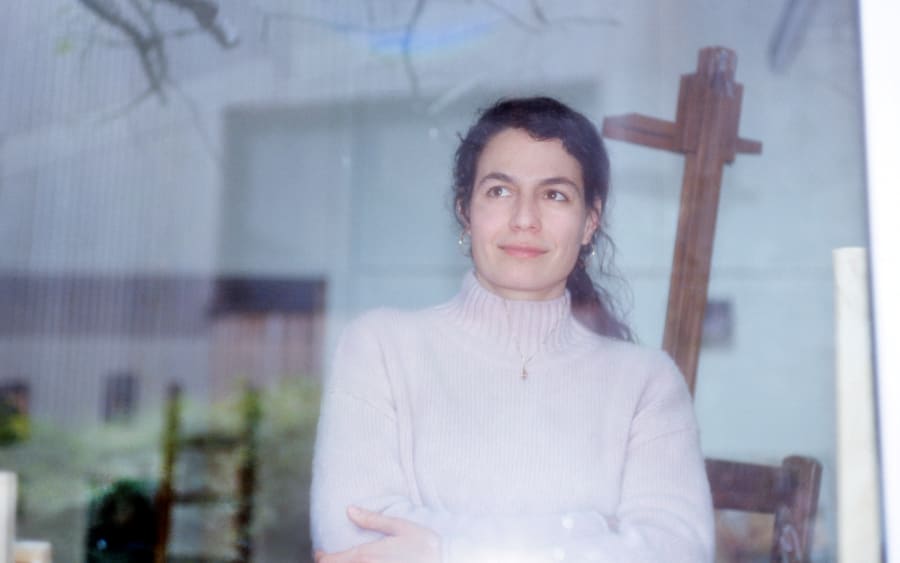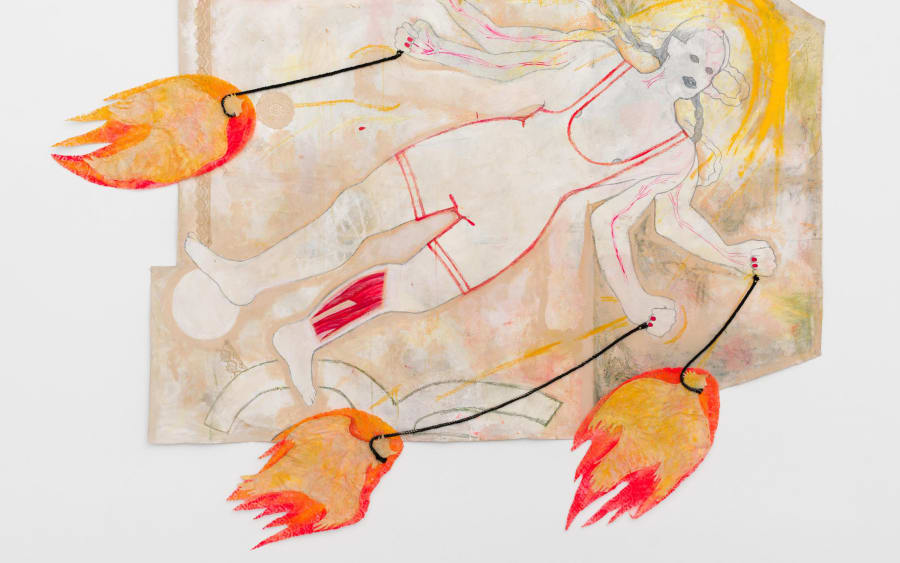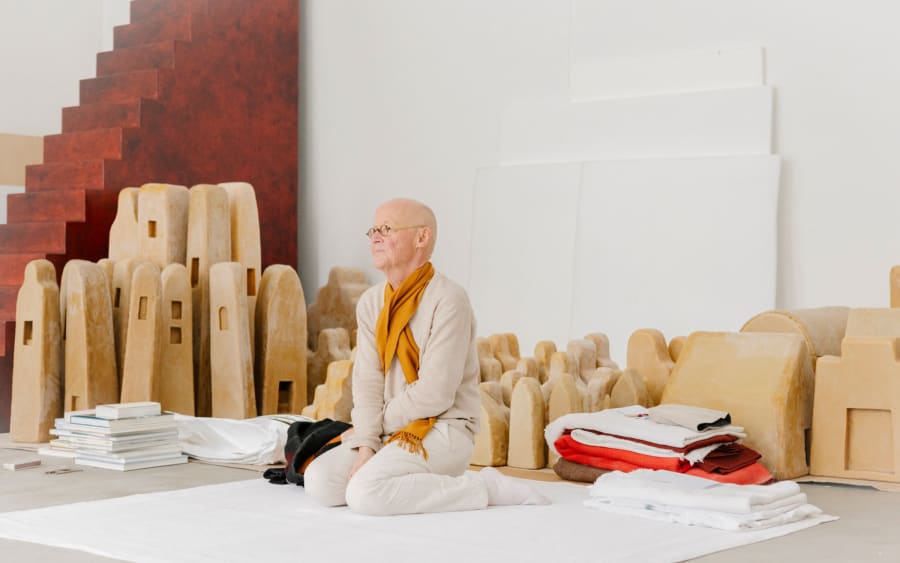Like many young artists, Soufiane Ababri found himself a bit stuck when he left art school – with no studio, and no money to rent one. So, he became – in his own, Duchampian words – an artiste de valise. The Moroccan artist, who today divides his time between Paris and Tangier, spent several years moving from one flatshare to the next, making and transporting his artworks, largely drawings, along the way. From 2016, Ababri began titling these pieces ‘Bedworks’ to reflect the fact that he makes them in bed. The series, which is arguably his best-known body of work to date, not only points to its site of production as a space distinct from a traditional studio – historically considered the norm for art production – but, for Ababri, also operates as a marker of class division and hierarchy.
’No one took me seriously at the beginning because I was working from my bed,’ he tells me when we meet at a café in Paris’s Marais neighborhood. Our capitalist society runs on efficiency and productivity, whereas ‘a bed is associated with laziness,’ he continues – and is conducive to neither. Ababri’s fate has clearly changed since. In recent years, he has had solo presentations at galleries including Praz-Delavallade (Paris), THE PILL (Istanbul), Dittrich & Schlechtriem (Berlin), and Mendes Wood DM (Brussels). On the day of our interview, he had just returned from opening his first major institutional solo show at The Curve gallery in London’s Barbican.
Entitled Their mouths were full of bumblebees but it was me who was pollinated (2024), this site-specific commission not only includes drawing but also performance and set design – two other significant components of Ababri’s visual vocabulary. The work responds to the architectural particularity of the exhibition venue: a monumental curve that gives the space its name. Brightly colored drawings hang on pitch-black walls or against alcoves hand-painted scarlet. Made in the artist’s signature medium of colored pencils and crayons on paper, they picture an imagined gay community in which mainly non-western male bodies – in various stages of undress, sexual arousal, and intimacy – meet, rest, play, and dance.
Ababri took inspiration from the similarity between the venue’s curvaceous form and the shape of the Arabic letter zayin (ز), which is also the first letter of zamel, a pejorative slang word used to insult gay men in the Maghreb. On the exhibition’s opening night, to the soundtrack of a muffled heavy bass – evoking the experience of standing outside a club – dancers performed a choreography that drew on Moroccan dance while touching on subjects that are at the core of Ababri’s work: belonging, homophobia, (post-)colonial violence, and the perennially exoticized and fetishized immigrant body. Pressed against the gallery’s curved walls, lying on their backs or crawling on all fours, the dancers appeared to refuse to stand upright. For the artist, this refusal to act ‘appropriately’ and the choreography as a whole – created in collaboration with choreographer Guillaume Le Pape – was part of a necessary reflection on how to reclaim imagery and gestures that belong to largely non-white, non-western communities at a time when these very same communities are living through a period fraught with tension and violence.
Taken as a whole, the exhibition is a ‘paranoiac project,’ explains Ababri, in which the space of the gallery is ‘throwing insults at you and sending signals more real than reality itself.’ Ababri is committed to addressing histories of violence and subverting dominant and normative regimes of representation. After a childhood spent in Rabat, the artist moved to France in 2004 to study psychology, before dropping out and immersing himself in the night-time shift work of gay bars and saunas. Having long harbored a desire to study art, Ababri was awakened to its political potential after seeing work by Bruce Nauman at a show in Montpellier. He took the plunge and enrolled at the École Supérieure des Beaux-Arts in Montpellier, before moving on to Paris’s École Nationale Supérieure des Arts Décoratifs. It was only after finishing his studies at the École Nationale Supérieure des Beaux-Arts de Lyon, however, that Ababri made the decision to place drawing – a medium that, historically, has been seen as painting’s poor cousin – at the center of his practice. He has aligned it with his own lived experience as a gay, Arab, immigrant man, brought up in a religious context but also as part of a generation well-versed in post-colonial thinking.
At once erotic and political, marked by a carnal, raw energy evident in the pencil marks, the men in his drawings constitute a chosen family of gay or subcultural icons, especially literary ones. (Jean Genet and writers associated with the Beat generation – Paul Bowles, William Burroughs, Allen Ginsberg – make recurring appearances.) They fill an art-historical and socio-political void, namely by portraying, as Ababri explains, ‘sexual relations between men of color.’ In doing so, they reclaim an agency for subjects that the western canon of painting has long presented as passive, spurred on by an Orientalist gaze that saw Arab men simply as slaves or exotic specimens, sexy figures to be readily consumed by a bourgeois and aristocratic public.
Ababri’s insistence on working from his bed, then, takes on an additional meaning: he purposefully rejects the traditional image of the artist painting while standing erect in front of his easel. This refusal of convention extends to the artist’s radical approach to self-portraiture. ‘The figure of the artist who represents himself as a genius just doesn’t sit well with me,’ he says. As if to drive the point home, Ababri incorporated fecal matter into his Autoportrait en excrément et rose et bleu (Self-Portrait in Pink and Blue with Excrement, 2022), one of a series of drawings exhibited last autumn as part of ‘SOL! The Regional Biennial’ at MO.CO, Montpellier. In this piece, Ababri attempts to liberate the scatological from its historical associations with mental illness and asylums while injecting a degree of impurity into the often-sterile environment of the art institution.
It would be tempting to say that Ababri’s practice flirts with the clandestine. The artist himself prefers the term ‘infiltration’ to describe a way of making political statements that does not necessarily rely on an activist vocabulary. His series ‘Bedwork / Yes I AM’ (2018–ongoing) takes as its starting point a chapter titled ‘Who Defends the Queer Child?’ from philosopher Paul B. Preciado’s book An Apartment on Uranus (2019). In it, Ababri draws individual portraits of gay men – including his contemporaries and predecessors, from Michel Foucault and the late curator Vincent Honoré to artists of his own generation, like Paul Maheke or Philipp Timischl – who, for him, make up a spiritual community. It unfolds as an ‘ongoing encyclopedia’ that celebrates and honors those who also strive to make themselves heard.
‘Their mouths were full of bumblebees but it was me who was pollinated’
On view until June 30, 2024
The Curve, Barbican Centre, London
Anya Harrison is a curator and writer based in Montpellier and Paris.
Caption for top image: Soufiane Ababri, Bedwork - Queen Boat Affair (detail), 2023. © Soufiane Ababri. Photo: Rebecca Fanuele. Courtesy of the artist and Barbican.
Published on April 9, 2024.


